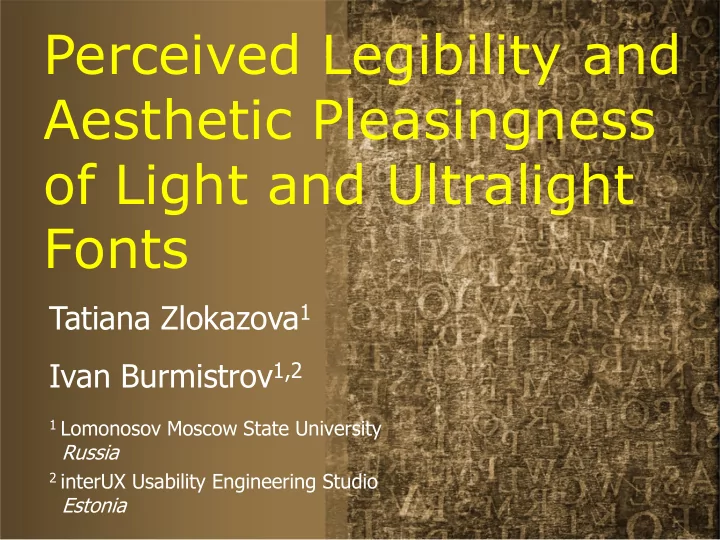

Perceived Legibility and Aesthetic Pleasingness of Light and Ultralight Fonts Tatiana Zlokazova 1 Ivan Burmistrov 1,2 1 Lomonosov Moscow State University Russia 2 interUX Usability Engineering Studio Estonia
Motivation of study Use of low-weight fonts – light and ultralight fonts – became the new norm in UI design Also, light and ultralight fonts are often combined with low text-to-background contrast and negative polarity However, new typographic aesthetics was not supported by any empirical research Nobody asked users about their attitudes to the new trends in type design This trend can be seen as only a fashion
Our research Two empirical studies (2016-2017): objective legibility measures like performance, saccadic amplitude and fixation duration (Burmistrov, Zlokazova, Ishmuratova, Semenova 2016) subjective perception of font legibility and aesthetic pleasingness: present study
Factors in both studies Font weight ( Helvetica Neue family): ultralight ▪ light ▪ normal ▪ bold Text-to-background contrast: low ▪ high Text-to-background polarity: positive negative ▪ 4×2×2 = 16 combinations
Objective data
Objectively measured legibility 182 The lower fixation 181 duration, the Fixation duration (ms) 180 better legibility. 179 Normal font is the 178 best, light and 177 ultralight fonts are 176 less legible than 175 normal and bold. 174 173 Ultralight Light Normal Bold
Subjective data
Stimuli
Task for study participants pairwise comparison of 16 stimuli: 120 pairwise comparisons within each of two series: evaluation of text legibility evaluation of text pleasingness
Instruction To provide comparability with classic research (Tinker & Paterson 1942): legibility was defined as “ease and speed of reading” no specific definition was provided for “pleasingness”
Participants 63 volunteers 21 male, 42 female 19-68 years old (mean: 39.0)
Data analysis Preference score for each stimulus was calculated as a sum of its selections in each series (Grobelny & Michalski 2015) Preference scores ranged 0 ÷ 15: 0 – if a stimulus lost in all pairwise comparisons 15 – if a stimulus won in all comparisons 4×2×2 ANCOVA with repeated measures (using age as a covariate) paired-samples Wilcoxon signed-rank test
Results
Effect of font weight 12 Normal is the best. Ultralight is the 10 Preference score worst. 8 Legibility of bold 6 almost the same as Legibility 4 of normal. Pleasingness Pleasingness of bold 2 almost the same as 0 of light. Ultralight Light Normal Bold
Interactions between factors Legibility: weight × contrast × polarity: Under low contrast and negative polarity all font variations showed significantly lower subjective rates of legibility The decrement of legibility scores under these conditions was more expressed for ultralight and light fonts Pleasingness: weight × contrast: Under low contrast condition all font types showed significantly lower subjective rates of pleasingness The decrement of pleasingness scores under low contrast condition was more expressed for ultralight and light fonts
Age differences: younger vs older users
Comparison of two age groups It is known that younger users may perceive fashionable user interfaces more positively than older users (Meyer 2016) 19-30 yo vs 45-68 yo (19 users) (23 users)
Subjectively perceived legibility 12 No significant differences 10 Legibility score 8 6 Younger 4 Older 2 0 Ultralight Light Normal Bold
Subjectively perceived pleasingness 12 The only significant difference: younger 10 Pleasingness score users perceived 8 ultralight font more positively than older 6 users Younger 4 …but still rated it as Older significantly less 2 pleasing than other 0 font variations Ultralight Light Normal Bold
Recommendations Ultralight fonts for body text should be avoided under any of the investigated conditions Negative polarity and low contrast conditions should be avoided for light fonts as there is a prominent negative effect on text legibility and pleasingness scores Limitation of our study: the situation may be different in case of large font sizes – such as headings
References Burmistrov I., Zlokazova T., Ishmuratova I., Semenova M. (2016) Legibility of light and ultra-light fonts: Eyetracking study, Proceedings of the 9th Nordic Conference on Human-Computer Interaction (NordiCHI ’16) , New York: ACM, Article 110 | DOI: 10.1145/2971485.2996745 Grobelny J., Michalski R. (2015) The role of background color, interletter spacing, and font size on preferences in the digital presentation of a product, Computers in Human Behavior , 43, 85-100 | DOI: 10.1016/j.chb.2014.10.036 Meyer K. (2016) Young adults appreciate flat design more than their parents do | Link Tinker M. A., Paterson D. G. (1942) Reader preferences and typography, Journal of Applied Psychology , 26 (1), 38-40 | DOI: 10.1037/h0061105
Thank you! Contact: ivan@interux.com
Recommend
More recommend